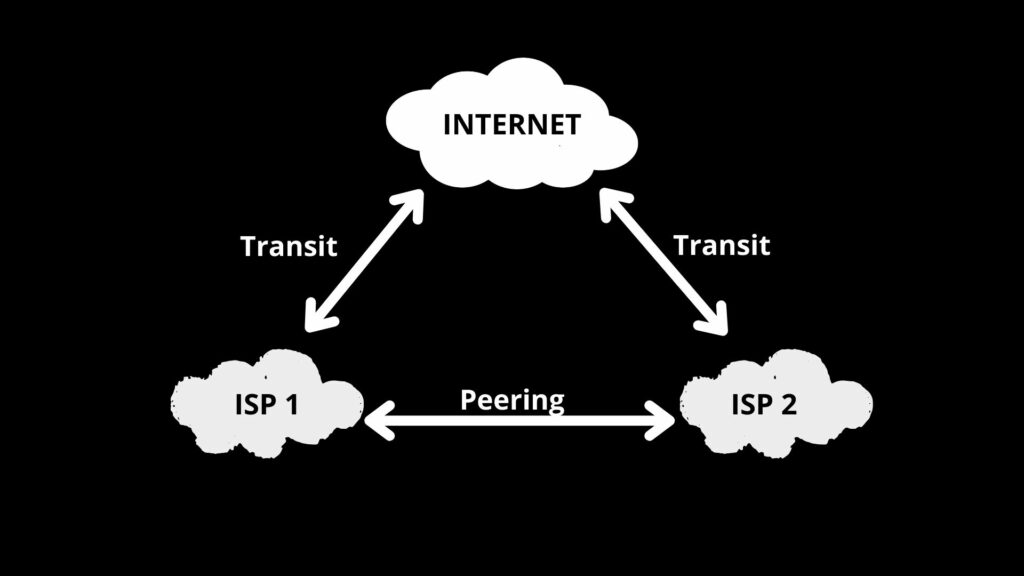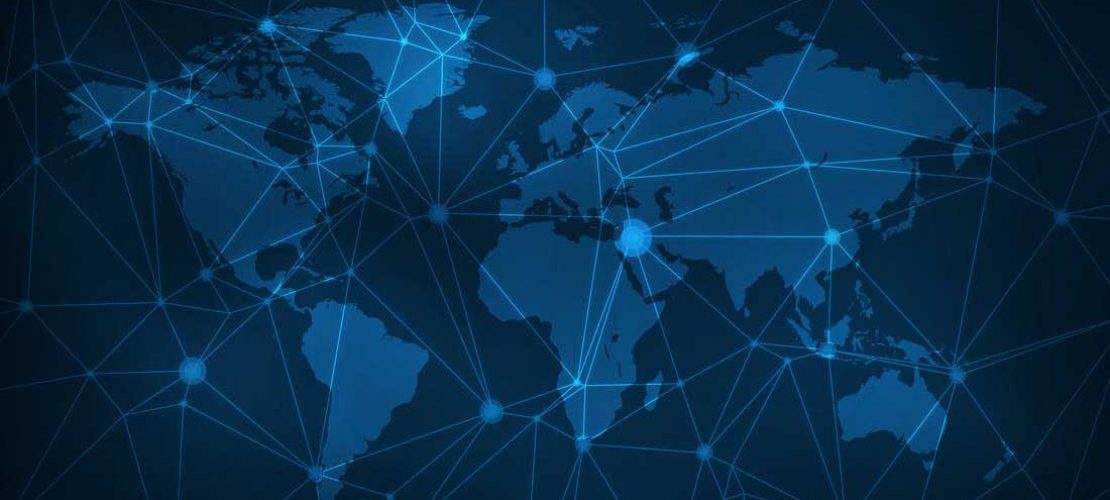The Internet today consists of many interconnected networks. Each network is called by a number called the AS number (to be introduced in another post). In addition to the fact that networks are connected by physical elements such as cables, routers, etc., connectivity is also defined by the contractual relationship between the two networks.
This relationship, if classified in general, can be divided into two types: IP transit and peering.
IP transit (IP transit):
A form of connection between a customer and an Internet provider. The customer will pay the supplier to connect to a location determined by the supplier (POP: point of presence). The connection from the PoP to the customer’s router (customer equipment) may be included in the transit contract or in another service (provided by the same or a different service provider). The Internet provider in this case will ensure that the customer can access every server on the Internet and vice versa, anywhere on the Internet can access the customer’s server. IP service transit usually comes with an SLA (Service Level Agreement). The SLA stipulates the quality of the service and the conditions for compensation when a customer does not have access to the Internet for a certain period of time.

Peering (peer-to-peer connection):
A form of connection that usually does not generate payments between the two parties. However, it should be noted that peering does not mean free. Depending on the conditions (peering agreement) between the two parties, the cost of peering can be divided equally in many ways (each party bears the cost to the connection point, or takes turns to pay for each connection …). In addition to the cost of the connection, each party will provide the other party with its customer route information, not the entire Internet’s routing information (the full route). This ensures that information is only exchanged between clients between two peering parties and that information is only shared between connections intended for peering without going through other connections and incurring unnecessary costs. set. It should be noted, peering is only a contract, how to ensure the correct routing information is exchanged must be technically guaranteed (routing, max prefix, prefix filter, as-path filter …). Failure to establish peering can lead to unexpected traffic concentration in transit connections (generating costs) or can affect the stability of the entire Internet.
By nature, Tier 1 ISPs are often connected to each other via peering. Suppliers and customers are connected via IP transit. But recently, with the rapid development of content providers, peering between content providers and ISPs is also common and becomes a risk for the development of service providers. Internet.
When ISPs are at odds, “bullying” each other
Normally, ISPs of the same level connect to each other without having a buying and selling relationship (called peering); Lower level ISPs that want to connect to the world through higher level ISPs have to pay for Internet connection service (called IP transit). However, in reality things are not so simple! When ISPs do not accept this “normal”, the Internet will have problems and the most disadvantaged are the end-users. In this article, I will give 2 examples: 1) when Tier 1s do not connect to each other and 2) when Tier 2 refuses to pay to connect to Tier 1.
When Tier 1 providers are not connected
In 2000, NTT Communications acquired one of Tier 1, Verio. At that time, the Tier 1s were mostly American, so our Uncle Sam felt hurt and proud! A series of US Tier 1 simultaneously “bullied”, disconnected from Verio (NTT Communications). What happened next?
Take for example Verizon disconnecting from NTT Communications. At that time, ISP A in the US that buys Verizon’s IP transit service cannot connect to ISP B in Japan that buys NTT Communications’ IP transit service (to be precise, it must add the condition that ISP A and ISP B do not connect). directly with each other and do not jointly purchase another Tier 1 IP transit service). That is, users of ISP B in Japan cannot view the website provided by ISP A providing Internet connection services in the US and vice versa. What will users and companies in Japan do when they can’t access their favorite websites and videos in the US? What will users and companies in the US do when they can’t access their favorite websites or watch videos in Japan? Of course, users and companies using ISP A’s Internet connection service, ISP B will constantly complain to the service provider. ISP A, ISP B continue to complain to Verizon and NTT Communications. The phone rang non-stop, the email was full of complaints. Now, who is the better complainant? If the situation does not improve completely, it is possible that ISPs such as ISP A, ISP B will cut their contracts with Verizon and NTT Communications. Finally, Tier 1s have to compromise, reconnect as before and users continue to surf the web, watch their favorite videos!
Yes you will ask Verizon and NTT Communications that are connected to Tier 1 of Europe (e.g. Telia of Sweden), why ISP A and ISP B can’t connect to each other through Telia (ISP A – Verizon – Telia – NTT Communications – ISP The answer lies in the peering connection between Telia and Verizon and NTT Communications Since Verizon and NTT Communications do not pay Telia to purchase IP transit service, information from Verizon to NTT Communications cannot be transferred. (transit) via Telia.
Typically, peer ISPs only allow their own clients to connect to each other’s clients. In this scenario, Telia customers can connect to Verizon customers and NTT Communications customers, but Verizon customers cannot connect to NTT Communications customers through Telia. At this point, you understand that these Tier 1 must connect directly to each other, not through another Tier 1 intermediary.
After this event, NTT Communications was recognized by other Tier 1s and became the only Tier 1 in Asia (at that time TATA had not been recognized by other Tier 1s).
2) When Tier 2 refuses to pay to connect to Tier 1
In the previous post, I mentioned a special case where Tier 2 China Telecom does not want to pay when connecting to Tier 1 (for example, TATA). MeanWhile TATA as Tier 1 wants to sell IP transit services, does not want to connect to China Telecom sluggish (peering). What will happen when TATA and China Telecom are at odds and cannot agree on how to connect with each other?
Since China Telecom buys IP transit service from Tier 1 in the US (e.g. Level 3), TATA also has a connection to Level 3 in the US, so the transmission will be as follows: China Telecom users – China Telecom (Asia) – Level 3 (USA) – TATA (Asia) – ISP C (TATA’s customer) – ISP C’s user. Thus, China Telecom’s users can still connect to ISP C’s (TATA’s customers) users. but the connection is sluggish because the information has to go around the world (from Asia to the US and then from the US to Asia). At this time, users of China Telecom and users of TATA are also complaining because the Internet connection is slow (but not as fierce as in example 1), so we have to see who is better at enduring customer complaints! If neither party compromises (TATA agrees to connect to China Telecom free in Asia or China Telecom agrees to pay for TATA’s Internet connection service in Asia), users of both parties continue to incur a Bilateral Internet connection scene that is sluggish.




